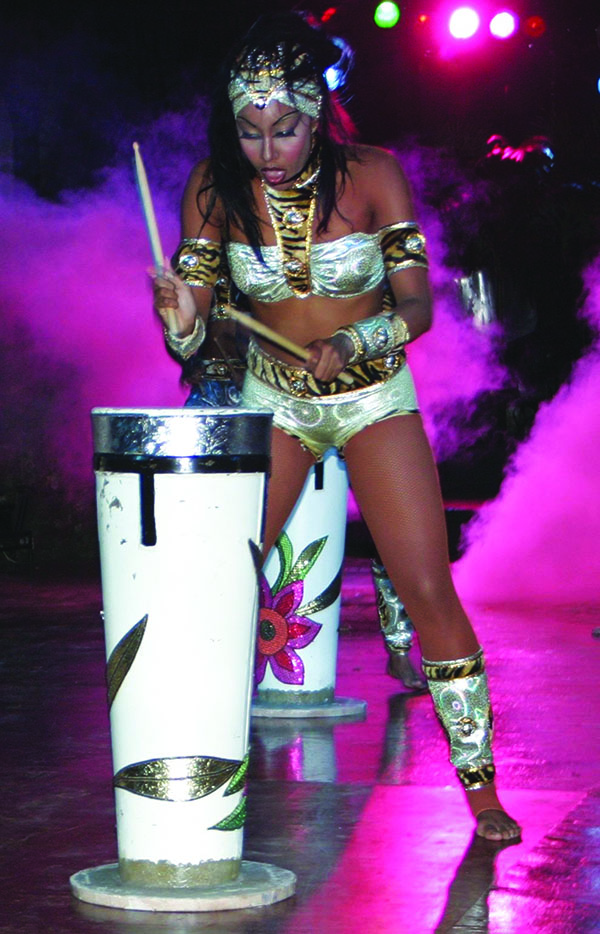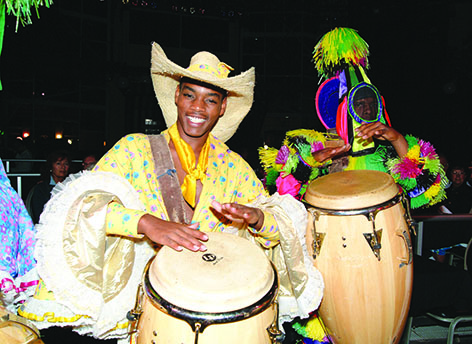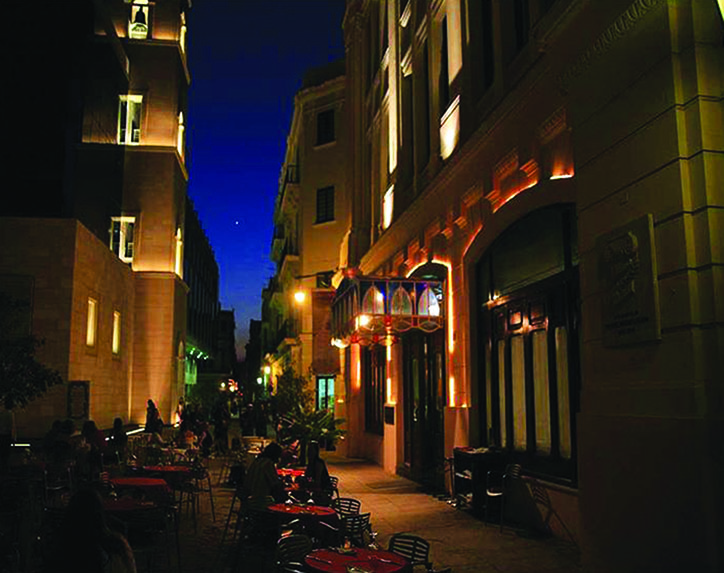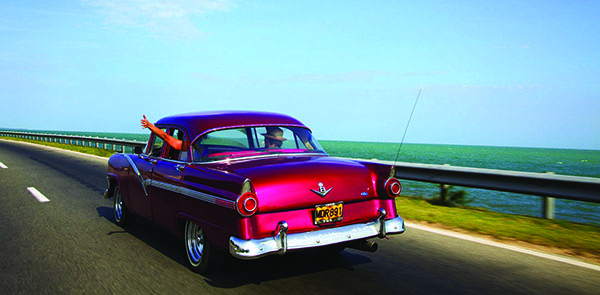By Ingrid Walter
PRIDE Contributing Writer
The smell of drifting sea salt permeates the light, breezy tropical night air. Sandals held in our hands, our bare feet burrow through millions of grains of spongy sand towards the sound of drums beating, and what, from a distance, looks like a large camp fire.
Embers from flames and ashes rise like dancing fireflies under the moon’s silver glow. The fire and drum beats draw us closer.
The night’s entertainment on Cuba’s Playa Pesquero beach, in Holguín, is meant to tantalize and mesmerize. A spectacle of cultural and historical influences, this north coast beach concert and dance party draws a huge crowd of eager tourists.
Buff, lean, colourfully and scantily costumed, agile men and women perform to a symphony of drums on a salty stage of sand. As the night’s entertainment unfolds, the music shifts and changes, incorporating African, Spanish, indigenous Cuban and even American sounds and rhythms. 
Tourists gather from everywhere, Canada, Europe, India, Russia and even the United States. Many try to mimic the performers; others seem transfixed, almost in a trance.
Although the ones from the US on the beach tonight are here on a special educational program, expectations are high, America’s doors will open wide once diplomatic ties are firmly re-established.
Politics aside, the future of Cuban American relations has never stopped this 110 square km island, bordered by the Atlantic to the north and the Caribbean to the south, from capitalizing on its past liaisons and conflicts. Today’s Cuba mixes sexy, at times scandalous and revolutionary history with varied cultural off shoots to entertain and market itself.
Like the rest of the Caribbean, this popular and price competitive destination provides island holiday standards.
All-inclusive hotels like the Spanish owned Iberostar, Riu and Melia chains are equipped with pools and pool bars, sunny beaches, water sports, spas, nightclubs and live bands.
Fishing and zip lining nature excursions, swims with Dolphins and more are relatively easy to arrange if you’re visiting Varadero or Cayo Coco, Cuba’s premiere tourist destinations.
With its feisty history and leadership, Cuba however distinguishes itself in the region. With expert packaging of a culture and history only Cuba can boast, it’s finding new ways to turn its old lemons into new lemonade.
Arguably the most intriguing aspect of the island’s history and cultural trappings belongs to the era when Cuba was the playground of America’s, and much of the world’s rich, famous and dangerous.
Virtually every American star signed with the Big Five Hollywood studios — 20th Century Fox, MGM, Paramount, RKO and Warner Brothers — gambled and, or partied, at Havana’s infamous Hotel Nacional de Cuba. It’s easy to understand why.
 Despite over 50 years of an economically devastating US embargo, Cuba has managed to maintain and preserve the essence of Le Nacional’s architecture and story.
Despite over 50 years of an economically devastating US embargo, Cuba has managed to maintain and preserve the essence of Le Nacional’s architecture and story.
Built in the nation’s capital in the 1930s, the hotel maintains over 400 rooms and luxury suites. Once the envy of those who couldn’t afford it; Havana’s most renowned hotel, also now a UN heritage site, sits on Taganana hill overlooking the city’s harbour and sea wall.
The verandahs are sprawling, anchored to the roof by towering Romanesque columns. Huge, comfy lounge chairs invite you to relax.
Musicians serenade on the hour and bars, bartenders, waiters and waitresses are ever-ready to serve mint leaf infused mojitos, rum drinks adorned with island fruits or any alcoholic or virgin beverage on a typical hotel menu.
A few steps from the verandah beyond a lush garden, is a terrace where you can sit opposite Havana’s sprawling boulevard and watch the sea crash against the shore.
History is everywhere, and even touches Le Nacional’s well-kept garden. Movie buffs will easily identify it as the site of that unforgettable scene in the iconic film, The Godfather, where minutes before fleeing Fidel Castro’s revolution, actor, Al Pacino, has that death inflicting conversation with “Fredo” the brother who betrays him.
Legends, fact and fiction mix and mingle in the organized tours Le Nacional offers. So if you stay there or simply visit, tour guides will let you peak into rooms where notorious mafia figures, like Lucky Luciano and Myer Lansky, once stayed, as well as those that catered to the whims of actors, like Ava Gardner, Frank Sinatra, Marlene Dietrich, Gary Cooper, Marlon Bando and, of course, probably Cuba’s most beloved American writer, Ernest Hemmingway.
Le Nacional offers dinner theatre performances by what seems to be an almost limitless supply of schooled dancers, singers and musicians who tell stories of passionate affairs between Spanish conquistadores and beautiful African women, Cuba’s colonial and imperial history, revolutionary battles and the bliss of freedom.
Costumed in colourful fabrics, frills and ruffles they salsa, samba, rumba and ballet to cabaret style choreography reminiscent of the Tropicana Club in its heyday.
Le Nacional is one of a number of hotels that capitalize on Cuba’s colourful history and culture to entertain tourists. Hotel Brisas Santa Lucia in Camagüey province, just south of Cayo Coco and west of the town of Holguín offers entertainment above and even below its waters.
While Cuban musicians play pool side, synchronized swimmers entertain. Choreographed synchronized swimming reminiscent of Hollywood’s 20th century aqua-musicals are taking on new forms in Cuba’s 21st century hotel pools.
If you are looking for experiences that move you even further along Cuba’s historical track, travelling into the interior of Camagüey province is an option.
The old town with its cobble stone squares, 15 churches and a canvas of green, yellow, blue and pink pastel exteriors is surrounded by myth and mystery.
Established by the Spanish in the 1500s, Camagüey is full of forked streets, blind and winding alleys and is said to have only one exit. Legend has it that the town was designed this way so its inhabitants could entrap and kill pirates who dared attack.
Today Camagüey boasts a number of sidewalk restaurants and is known for one in particular. La Campana de Toledo created from a restored 18th-century house offers in and outside dining on traditional meat, fish and rice dishes, wine, Cuban beer and lots of rum.
Like most Caribbean island tourist destinations, sugar cane and rum were the products that once made Cuba the target of pirates, and the envy of rivalling colonial powers. 
My visit to the Patria Sugar Mill in Morón, not only gave me a breezy chug along ride on an old steam engine that transported what was once pricey sugar cane, I got a history lesson with a twist, in the form of a telling skit.
With my hand cupping a drink of Havana Club mixed with lemon and honey, courtesy of the mill, now a museum; I watched and listened as ebony skinned, Cuban women dressed in long white cotton dresses sang, pretending to chop and gather sugar cane under the hot sun.
They were depicting African slaves on an 18th century plantation in Central Cuba’s Ciego de Avila Province. The singing abruptly stopped. The plantation’s white overseer had started to paw, then beat the women with a long, dirty whip – but not for long. With a few strategic moves, the women overwhelmed the overseer and quickly chained him to a wooden post.
Stories of the Cuban people’s relentless fight for freedom are told through songs, dance and theatre. They also are found on billboards and the walls of many buildings.
Whether travelling by taxi in a scarlet red 1950’s Chevy or Cadillac, by train, horse and buggy or on an umbrella fitted bicycle, you’ll see drawings and paintings of the men and women who shaped Cuba’s history.
Images of Jose Marti, Fidel Castro, Che Guevara and yes Lenin too, are an integral part of the scenery in virtually every town and city. But Lenin and Russian communist ideology seems a relic today in Cuba.
It is a country that does business with European multinational hotel chains and aggressively capitalizes on what is, undeniably, one of its greatest assets — a distinct and controversial history and culture.
 Pride News Canada's Leader In African Canadian & Caribbean News, Views & Lifestyle
Pride News Canada's Leader In African Canadian & Caribbean News, Views & Lifestyle





